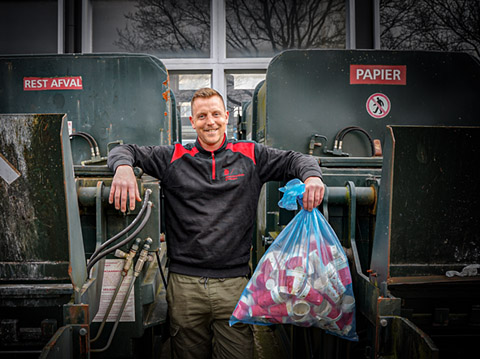
Apple cores and plastic in with the cups
Separating trash can be confounding
1 million kilos of waste
Students and staff at the UG create approximately a million kilos of waste at the campus. Half of that constitutes general waste. The Covid pandemic saw this number nearly cut in half, and the amount of general waste decreased by another thirty tonnes last year. However, the amount of paper collected increased by twenty tonnes.
Whether the waste separation is going well is difficult to calculate, the Green Office says. The new system started halfway through the calendar year and the pandemic is a distorting factor.
In addition to providing the five different bins, the UG has another fifteen waste streams, including computers, wood, metal, glass, manure, confidential papers, and chemical waste.
‘This is paper waste.’ Jesse Benne pulls another bag from the cart he just pushed from the Linneausborg to the waste separation station next to the building. The cart is filled with bags from the recycling bins that were introduced at the university a year ago and which separate your trash into five categories: paper, cups, organic waste, plastic, and general waste.
He rejects the bag. ‘There are cups in there, and there’s plastic in cups’, he explains.
He throws the bag into a cart that’s nearly identical to his own collection cart; just as big, shiny, and black. To distinguish it from the others, Benne and his fellow custodians stencilled the Dutch word for general waste on it in capital letters. Because they had these carts, they had to throw the waste directly into the compactors. It was awkward, time-consuming, and not very safe.
But it was still better than how it worked the first few months, when they didn’t even have the different containers. They didn’t even have any cloths to clean the bins with. It was complete chaos, says Benne.
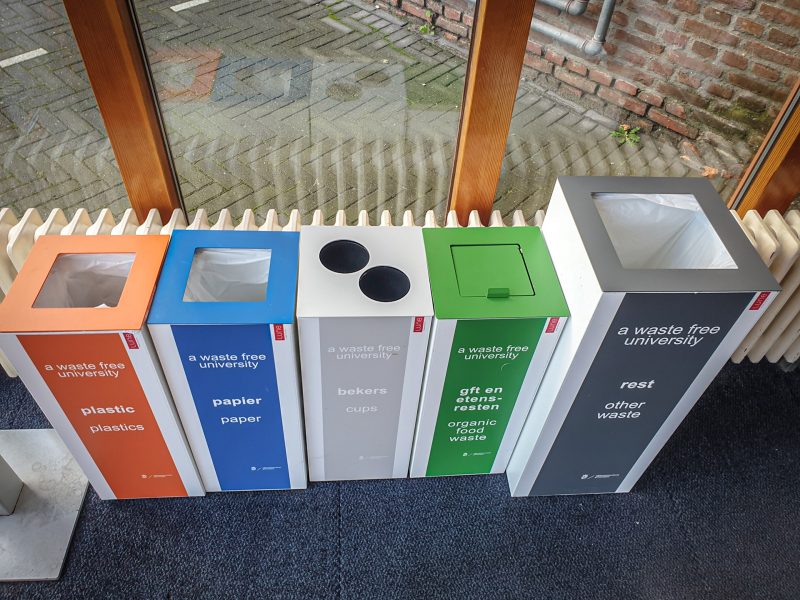
The colourful recycling bins can be found all over the university
Pizza boxes and wine bottles
The recycling bins were put out before everything behind the scenes had been sorted. There are still plenty of things that are going wrong.
But not on Benne’s watch. He grabs the next bag. ‘These are supposed to only be cups, but it’s obviously general waste. There are all sorts of things in there: paper, plastic, plastic’, he points. He approves the next bag, filled with paper, and tears it open over the large paper container.
Going through the bags of ‘dirty waste’ isn’t part of their job
‘It’s great what Jesse’s doing’, says his team leader Arthur Hilberdink proudly. But do all custodians tear open the bags of paper waste? No. That’s also because it’s a health and safety issue, since going through the bags of ‘dirty waste’ isn’t part of their job. The custodians are supposed to empty the bins, clean the lids with a cloth, and throw the bags into their corresponding containers. That’s all they need to do, says Hilberdink. ‘It’s hard work.
When someone’s left pizza boxes or wine bottles next to the bins, they leave them there for in-house services. When the bins are particularly dirty, they alert the cleaning department. They definitely don’t empty personal bins people secretly keep in their own offices. ‘That’s not our job’, says Hilberdink.
His team consists of people who have a hard time keeping a normal job, for various reasons. They need a little bit more supervision, but they also save the university a lot of money. Custodians get paid less than the cleaners who used to empty out the bins, and the UG receives a subsidy to employ them.
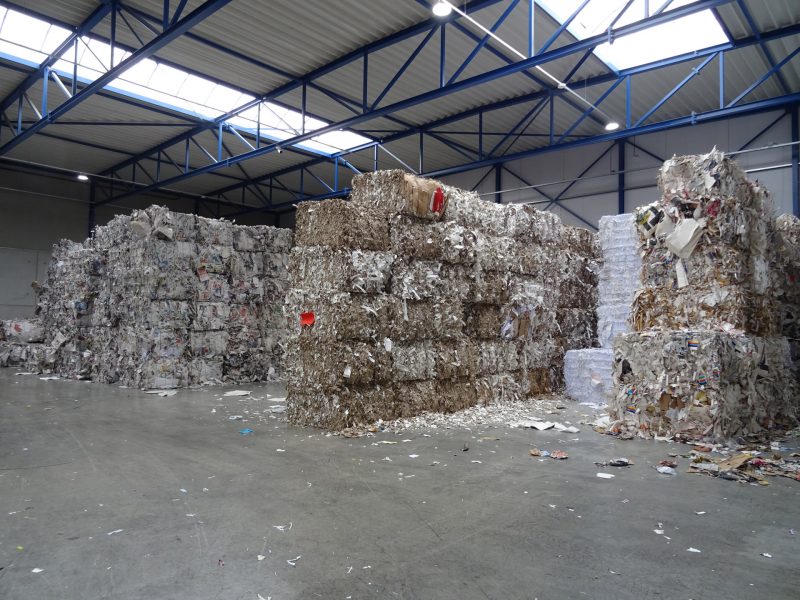
Bales of waste paper at Virol
Cardboard
When the custodians are done, the paper is sent to a facility in Scheemda, where waste processing company Virol compresses it into bales weighing eight hundred kilos. These are then transported to one of the paper factories in the North, to be turned into cardboard that’s used for the back of notepads, among other things. Virol’s commercial director Freerk Potze thinks it’s a great process.
If it’s only for the sake of appearance, I’d feel a little cheated
Cups go through a similar process as the paper. But Potze is less happy with how that goes. ‘The cup waste is often contaminated.’ Mixed in with the waste are apple cores, pieces of plastic, stirring sticks; none of it should be there. ‘Some locations do better than others, I have to say’, says Potze in an effort to be diplomatic. If there’s too much other waste mixed in, the batch gets sent to the general waste processing plant, where it gets burned.
What’s an acceptable level of contamination? ‘None’, says Potze. All that’s allowed is the plastic layer in the cups, but that’s it. His processing plants are configured to deal with those, he says. The paper fibre is dissolved in water and the plastic layer is skimmed off.
Mistake
The processing of organic waste isn’t easy, either. Renewi uses fermenters to turn the waste into green gas or to generate green electricity. But that means the organic waste can’t be collected in plastic bags, the waste processing company says.
Benne’s green wheelie bin, stuffed full of plastic bags with each just a little bit of waste, shows the concept needs work. But, says Renewi, it’s ‘only a few locations’ where this happens.
‘And lastly, here’s a bag of plastic’, Benne continues. ‘It goes in the general waste pile.’ Always? Always. No matter how hard the students and staff at the UG have tried to separate their waste, all the plastic goes into the same compactor as the general waste.
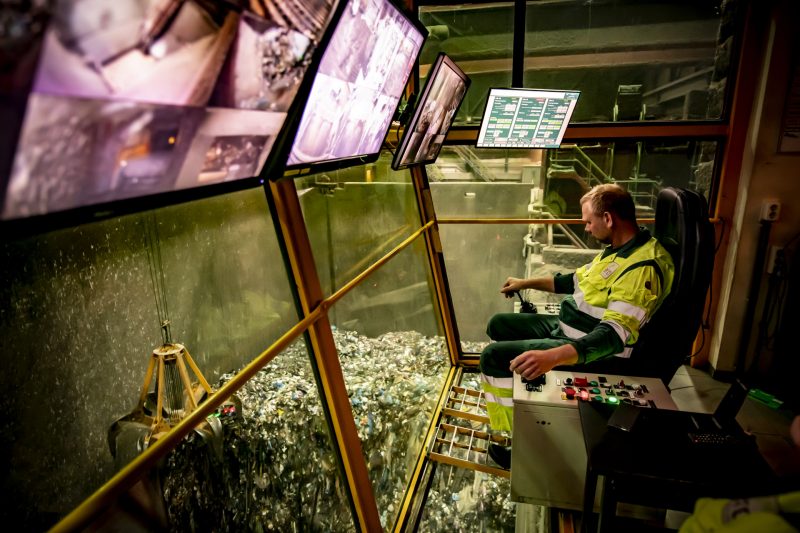
Waste separation at Attero
Plastic
‘Oh’, says associate professor Peter Groote when he hears this. He always separates his plastic waste meticulously, throwing it into the blue bin. He’s a ‘big proponent’ of waste separation, he says. ‘But only if it’s actually effective. If it’s only for the sake of appearance, I’d feel a little cheated.’
Regular people already have a hard time separating waste
Yonne Klein Kranenburg, contract manager at the University Services Department, which handles the waste separation, doesn’t understand his reaction. ‘We were very transparent about our options and choices right from the start.’ According to her, there’s currently simply no proper way to process plastic. But when that time comes, the UG will be ready, she says.
Right now, the plastic joins the general waste at the Attero waste separation facility in Wijster, where they separate it according to seven different categories, such as PET, plastic film (as used in bread bags), polyethylene (butter tubs), polypropylene (shampoo bottles), and drink cartons. The rest of the general waste gets burned, which the facility uses to generate electricity.
Difficult
Attero confirms that separating your plastic from your general waste is still fairly pointless. The facility uses sensor technology to separate plastic from general waste, but can’t really do the reverse. Too much general waste mixed in with the plastic means extra work for the sorting facility, which isn’t equipped to handle that. There is a national agreement that only 15 percent of waste can be contaminated.
The question remains whether people at the UG are even capable of properly separating their waste, says spokesperson Robert Corijn. ‘Regular people already have a hard time doing that. The university is full of students running to and fro, and then they’re also expected to find the right bin for their waste.’
But professor of environmentology Henk Moll says it’s not impossible. It’s already being done in large parts of the country. ‘But you have to make it extremely clear what goes where.’ He’s actually quite critical of separating the different types of plastics. ‘First of all, it’s contaminated, and second of all, it’s all mixed up. You can’t really use the individual plastics for very much.’ Sure, it could be added to concrete as a carbon additive, but that’s not really a high-quality use.
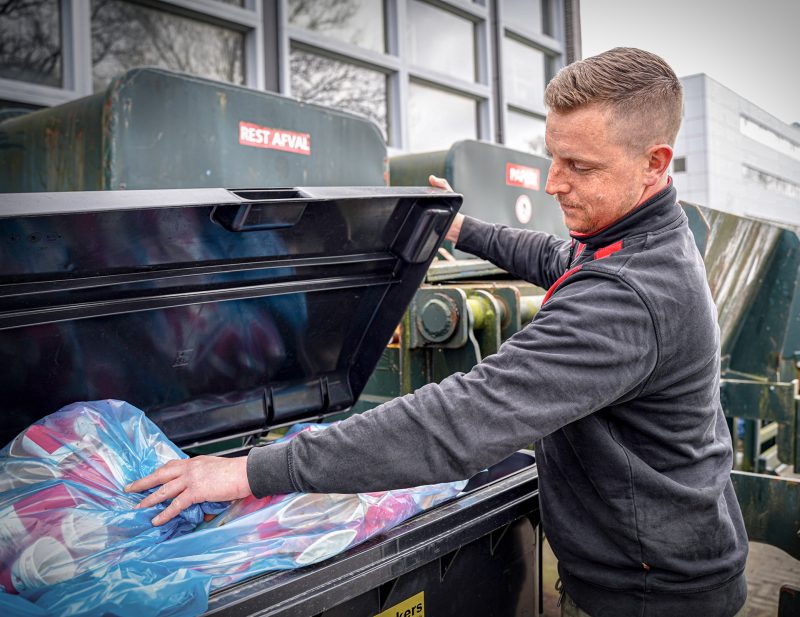
Subsequent separation
So why do any subsequent separation of waste at all? Klein Kranenburg says the Green Office wanted it. She also thinks it’s ‘a valuable addition to the general waste contract’.
Not at all, says Sander Dijkstra with the Green Office, we always said that separating at the source was important. ‘The quality is also better if you separate at the source.’
After collection, everything was thrown into the same trash compactor
Martin van Urk with Lune, the company that provides the recycling bins, is surprised to hear that the plastics join the general waste at the facility. He’s in touch with Klein Kranenburg about the waste collection on a weekly basis. But if he’d known about this, he says, he would’ve helped brainstorm different ways of waste collection. ‘I’ve seen it once before at Windesheim, where they separated the waste on site, but then threw it all in the same compactor.’
That project was temporarily halted, says Van Urk. ‘They started it up again later, and now everything’s going great.’
But the UG will continue its current trend. The university wants 95 percent of all waste to be separated by 2025. It would also like to see a 15 percent decrease in waste. The university is investigating how they can separate the waste from the outside bins on UG property. ‘We might start a pilot in the BSS garden’, says Cathy Hermans with Grounds Management. However, this project is separate to the waste collection project inside the UG buildings. They’re not in contact with Klein Kranenburg.
What goes where?
Tissue dry → paper, tissue wet → general waste
Napkin dry → paper, napkin wet/used/dirty → general waste
Yoghurt drink container → general waste
Beijk paper container → paper
Beijk paper container with mayonnaise → general waste
Wooden stirring stick → general waste
Pizza box clean (frozen pizza) → cardboard, pizza box used → general waste
Bubble wrap envelope → general waste
Paper cups from outside the UG → If it’s a drink cup: with the coffee cups
Beijk soup container → general waste
Tea bag → general waste
Milk carton → general waste
Beijk bread bag made with plastic and paper → general waste
Chewing gum → general waste